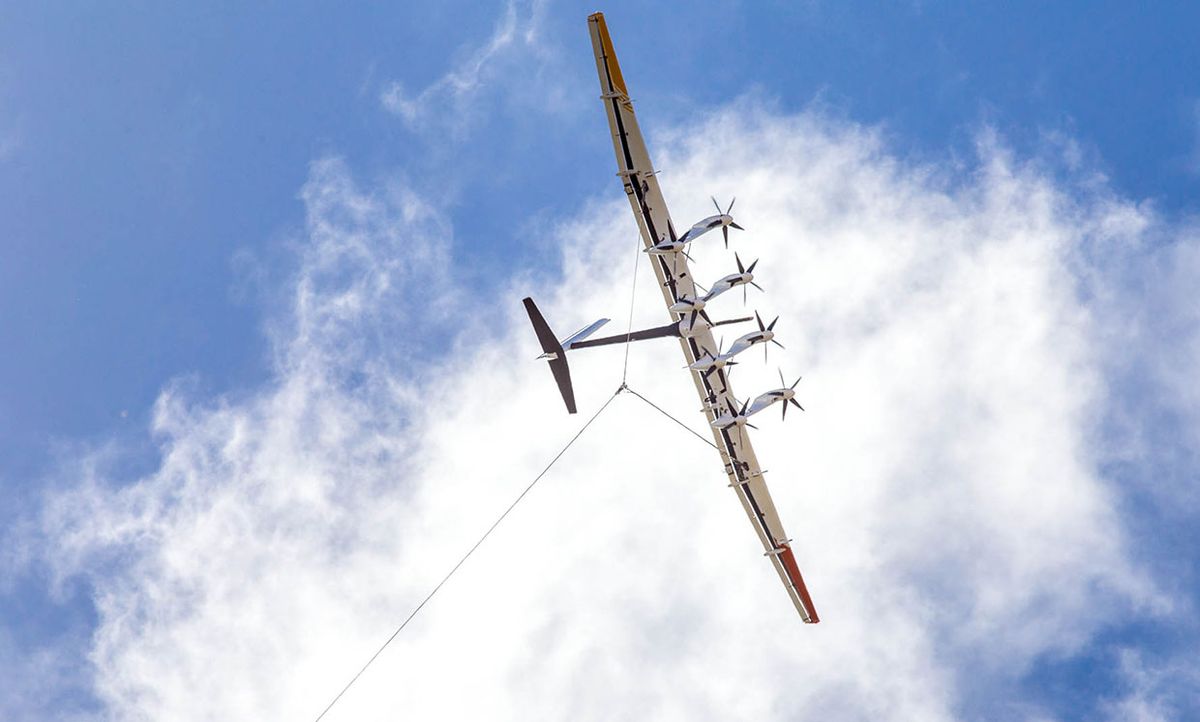Renewable energy technologies seem to fill every nook and cranny of the earth. Turbines generate power on the seafloor and off coastlines. Solar panels carpet desolate deserts and abandoned wastelands. Volcanic aquifers, mountain streams, and urban sewage systems all help to produce electricity. For Makani, an airborne wind energy company, the next place to tap is roughly 300 meters in the air.
The California startup recently spun out of X—Alphabet’s experimental technology lab, or “moon shot factory”—to become an independent business within Google’s parent company. Makani is also partnering with Royal Dutch Shell in a bid to launch the startup’s high-flying kites where they haven’t flown before: offshore.
Starting this year, Makani will begin testing a floating system for one of its kites at the Metcentre, an offshore wind testing facility in southwest Norway. The kite will be tethered to a small spar buoy, which itself will be moored with a synthetic line and a gravity anchor. The goal is to operate where today’s floating wind turbines can’t go, either because it’s too challenging or cost-prohibitive to build supportive platforms.
“Two-thirds of coastal waters globally are too deep for today’s wind technology to economically access these resources. This is where we think Makani can help," Fort Felker, the CEO of Makani, said in a blog post published 12 February announcing the partnership. (An X representative said Makani and X employees were unavailable for interviews.)
Makani is one of a few startups seeking to harness the higher-speed, more consistent winds that blow at higher altitudes than conventional turbines can reach. Before joining X in 2013, Makani garnered tens of millions of dollars in support from Google’s philanthropic arm and the Advanced Research Projects Agency-Energy at the U.S. Department of Energy. The startup has since scaled its 20-kilowatt proof-of-concept kite into a 600-kilowatt commercial prototype, which engineers are testing at a site in Parker Ranch, Hawaii.
Video: Makani
The current prototype features a carbon fiber wing spanning 26 meters, or about the wingspan of a small jet airliner. A tether stretching nearly half a kilometer long connects the kite to a ground station. Prior to flight, the station rotates to position the kite downwind. Engineers then use a flight control system to spin the kite’s eight rotors and lift it vertically, like a powerful drone.
Once the kite reaches a height of about 300 meters, it begins gliding in vertical loops, spinning the rotors and driving a permanent magnet motor-generator. Electricity moves down the conductive tether and is transferred onto the grid. Makani says its kites are 90 percent lighter than turbines of a similar power rating, owing to the use of “lightweight electronics and smart software” instead of steel.
As Makani transfers to the craggy coastlines of Norway, engineers will tailor this system for the water. That’s where Shell comes in.

The energy giant, which reported $21.4 billion in 2018 profits, has decades of experience operating offshore systems for oil and gas production. It’s also investing heavily in alternative fuels, grid systems, and early-stage renewable technologies. In recent weeks, Shell announced it was acquiring Sonnen, a German energy storage company, and the electric-vehicle charging startup Greenlots. With Makani, Shell is a minority shareholder and technical partner, though deal terms remain confidential.
“Shell has big ambitions to grow our renewable power business, and we see great potential in floating offshore wind,” Dorine Bosman, vice president of wind development at Shell, said in an emailed statement. Shell is “delighted to be partnering with Makani to help deploy and test their innovative energy kite technology in this environment,” she added.
Shell's moves reflect a broader push by oil and gas majors to diversify their energy portfolios. As global transportation networks—cars, trucks, trains, ships—begin to electrify, these behemoth businesses are looking to claim a slice of the future. At the same time, countries and companies worldwide are adopting climate change strategies and pushing to replace fossil fuels with low-carbon technologies.
“Most oil and gas majors are thinking a lot about electricity these days,” says Joshua Rhodes, a research associate at the University of Texas at Austin's Energy Institute. “They’re in the business of providing energy for mobility.” In that context, it makes sense for Shell to partner with a cutting-edge startup like Makani.
"For them to get that on their radar in the early stage would be advantageous to [Shell]," Rhodes adds.
Yet as Makani expands into the offshore environment, Prashant Khorana, a renewable energy analyst at the consulting group Wood Mackenzie, in Denmark, says the technology has more potential to thrive on land.
Khorana says he’s skeptical that the wind energy kites will be able to compete with floating offshore wind farms, even if the buoys can access trickier locales. The high-flying turbines won't likely be able to produce power at a similar or lower cost of electricity than the multigigawatt floating-turbine pilot projects popping up worldwide. It's also still unclear how flying kites will be regulated in offshore environments, he added.
However, airborne wind energy systems could establish a solid niche market in other challenging terrains, such as as mountainous areas where it’s too cold or dark to use solar panels or too rugged to install wind turbines. "It's impossible to say 'no' to [technologies] like this, because there's always niches they can play in," Khorana says.



